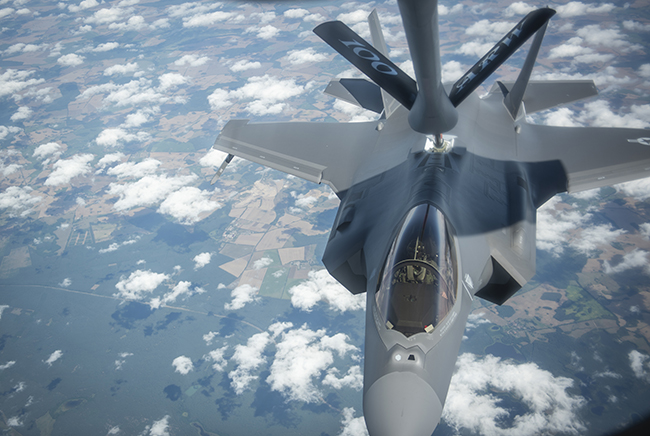
A USAF F-35A assigned to the 388th Fighter Wing at Hill AFB, Utah, receives fuel from a KC-135 Stratotanker assigned to the 351st Air Refueling Squadron at RAF Mildenhall, UK, during Operation Rapid Forge over Germany, on July 23, 2019. Air Force photo by TSgt. Emerson Nuñez.
The Air Force has begun loading its F-35As with the Automatic Ground Collision Avoidance System seven years sooner than planned, Lockheed Martin announced.
Jets at Eglin AFB, Fla. and Mountain Home AFB, Idaho, are the first to receive the software modification, a Lockheed spokesman said. Eglin is a main F-35 training base, and Mountain Home is housing Hill AFB, Utah, F-35As while their home base undergoes runway repair.
The upgrade was originally expected to be installed on the F-35 in 2026, but its potential value prompted program managers to accelerate the schedule, using a “rapid, agile development, test and contracting approach,” Lockheed said in a release. The 412th Test Wing at Edwards AFB, Calif., expedited testing of the system.
Newly installed F-35 Program Executive Officer USAF Lt. Gen. Eric Fick said Auto-GCAS is a “proven system that is long overdue” for fielding. Getting it out to operational units will “bring more warfighters home,” he said in a statement.
Over the life of the F-35, Auto-GCAS will likely prevent some 26 crashes, Fick claimed, adding “it will save lives.” After installation on the F-35A, the F-35B and F-35C will get the upgrade.
The Auto-GCAS system was developed in a partnership of NASA and the Air Force Research Laboratory, and received this year’s Robert J. Collier Trophy for innovation in aeronautics. It uses terrain mapping, geolocation, and autonomy to anticipate ground collisions. When it recognizes an imminent crash, the system will warn the pilot. If there is no response, the system will automatically fly the aircraft up and away from terrain. Once on a safe path, control is returned to the pilot.
The system has been operating on the F-16 for five years and is credited with preventing eight crashes in that period. The F-22 also has an auto-GCAS system, though it differs by using a “line in the sky” approach to collision avoidance rather than a combination of sensor inputs.